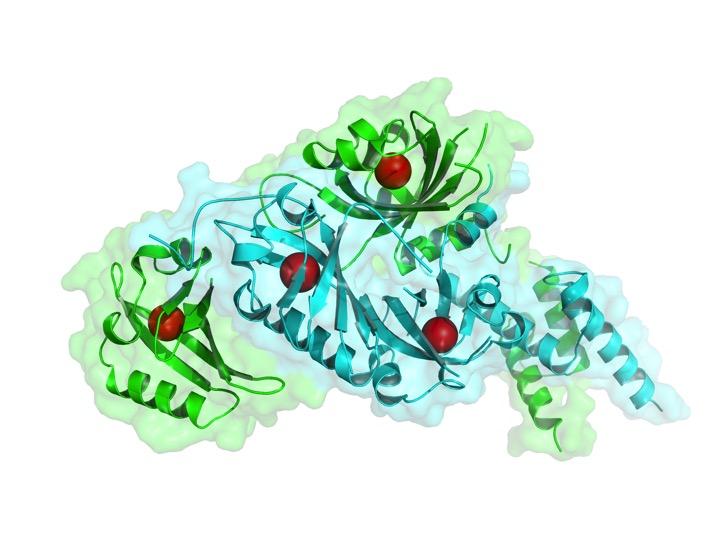
Credit: Dalei Wu, Sanford Burnham Prebys Medical Discovery Institute
National Institutes of Health, Department of Defense Congressionally Directed Medical Research Program
La Jolla, Calif., November 3, 2016 — An entire class of proteins called transcription factors, which regulate the activity of certain genes by interacting with specific sequences of DNA, has largely been ignored by the pharmaceutical industry because it's difficult to design and screen drugs against them. But a new study from scientists at Sanford Burnham Prebys Medical Discovery Institute suggests that a key group of transcription factors are in fact 'druggable,' including several that could be targeted to treat cancer, metabolic disease, or autoimmune conditions.
"We found that at least seven bHLH-PAS proteins have pockets where drugs would fit and remain tightly bound," said Fraydoon Rastinejad, Ph.D., professor in the Integrative Metabolism Program and senior author of the study. "That strongly suggests that all members of the family have similar, but chemically distinct, crevices that could bind drugs. Since these proteins serve as 'master regulators' for controlling whole gene programs, drugs against these targets could have broader effects than traditional ones that block single enzymes."
In the new study, published in eLIFE, Rastinejad and his lab first determined the structures of NPAS 1 and NPAS 3 proteins, each in complex with their partner, ARNT, using X-ray crystallography. All three proteins belong to the bHLH-PAS family of transcription factors. NPAS1 and NPAS3 control genes involved in brain and spinal cord development.
Rastinejad's team then compared the new structures to those of four other bHLH-PAS proteins, including two they previously solved, hypoxia-inducible factors (HIFs) 1α and 2α. In all seven proteins, they observed two similarly sized and architecturally positioned cavities in which small molecules could fit. Since three more bHLH-PAS transcription factors were known to interact with small molecules, it's safe to assume that these pockets are a common feature of the whole bHLH-PAS family.
Although variations in the NPAS1 and NPAS3 genes have been linked to brain disorders including autism, they aren't obvious drug targets because their function is most important in early life. However, modulating the activity of other bHLH-PAS proteins has been proposed to treat several diseases. For example, using drugs to block HIFs, which help cells survive when little oxygen is available, could stop the growth of certain cancers. Altering the function of the clock circadian regulator (CLOCK) and brain and muscle ARNT-like protein 1 (BMAL1), which keep cellular functions synchronized with day-night rhythms, could treat metabolic problems. And the aryl hydrocarbon receptor (AHR), which controls T cell differentiation, is a potential target for drugs to alleviate autoimmune disease.
"The fact that bHLH-PAS proteins have ligand-binding pockets insides their architectures suggests they're regulated by small molecules that are naturally found in the body," added Rastinejad. "That means we have a lot left to discover about these transcription factors. We anticipate that this research will spur many investigations to find their native activators and inhibitors and determine how they affect each protein's activity."
###
This research was performed in collaboration with scientists at the Argonne National Laboratory. Funding was provided by the National Institutes of Health and the Department of Defense Congressionally Directed Medical Research Program.
About SBP
Sanford Burnham Prebys Medical Discovery Institute (SBP) is an independent nonprofit medical research organization that conducts world-class, collaborative, biological research and translates its discoveries for the benefit of patients. SBP focuses its research on cancer, immunity, neurodegeneration, metabolic disorders and rare children's diseases. The Institute invests in talent, technology and partnerships to accelerate the translation of laboratory discoveries that will have the greatest impact on patients. Recognized for its world-class NCI-designated Cancer Center and the Conrad Prebys Center for Chemical Genomics, SBP employs about 1,100 scientists and staff in San Diego (La Jolla), Calif., and Orlando (Lake Nona), Fla. For more information, visit us at SBPdiscovery.org or on Facebook at facebook.com/SBPdiscovery and on Twitter @SBPdiscovery.
Media Contact
Kristen Cusato
[email protected]
858-795-5126
@sbpdiscovery
http://www.sbpdiscovery.org/





